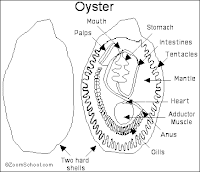- jointed-leg animal: invertebrate with an outside skeleton.
- appendage: structure that grows out of an animal body.
- exoskeleton: skeleton on the outside of the body.
- molting: shelding the exoskeleton.
- antennae: appendages of the head used for sensing smell and touch.
- compund eyes: eyes with many lenses.
- spiny-skin animal: invertebrate with a five part body design and spines.
- tube feet; parts like suctions cups that help to get food, attach and move.
- chordate: animal, that in some point of his live, has, a tough, flexible rod along it's back.
- endoskeleton: skeleton inside the body.
- cold-blooded: having body temperature that changes with the temperature of the surroundings.
- gill: structure used to breathe in water.
- jawless fish: fish that have no jaw and are not covered by scales.
- cartilage: tough flexible tissue that supports and shapes the body.
- cartilage fish: fish in which the entire skeleton is made of cartilage.
- bony fish: fishes that have skeleton made mostly of bone.
- amphibian: animal that lives part of his live in water and the other part in land.
- hibernation: state of being inactive during cold weather.
- reptile: animal with dry, scaly skin and live on land.
- warm-blooded: controling the body temperature so its stays about the same no matter the surrounding's temperature.
- mammal: animal with hair that feeds milk to its young.
- mammary glands: body parts that produce milk.
Illustrations:
1- jointed-leg animal:
2- appendage
3-exoskeleton
4- molting
5- antennae
7- spiny-skin animal
8- tube feet
9-chordate
10- endoskeleton
11- cold-blooded
13- jawless fish
15- cartilage fish
16- bony fish
21- mammal























































